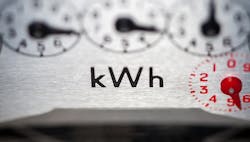Most of us are familiar with our home’s electric bill charges for energy (kWh) usage. The bills for larger customers, including manufacturers, contain other components, such as demand and power factor (we will cover this next month in Part 2). They also show the individual charges that lead to the final dollar amount, and whether or not you are paying sales taxes. Understanding these items, together with rate tariff structures, provides valuable information that can lead to significant savings.
[pullquote]
Demand is the rate of energy use per time, which equates to power. It is measured in kW or kVA; the demand charges are in $/kW or $/kVA. Utilities measure the energy usage in discreet windows of time, often for 15 minutes, and determine the demand by dividing the kWh by 0.25 hour. They do this for every 15-minute period in the billing month. Many billing tariffs use the single highest demand as the billed demand for a month.
Many utilities have multiple rate tariffs to better serve different classes of customers, with certain tariffs suggested given the electric demand. For instance, a gas services (GS) tariff is suggested for plants with a demand of less than 400 kW. The large general service (LGS) tariff is used for higher demand levels. The GS may feature higher energy costs and lower demand cost, compared to the LGS which has lower energy costs but higher demand costs. Depending upon the exact nature of your plant’s energy and demand usage, your final bill may be less on one tariff or the other. Texas A&M University’s Industrial Assessment Center recently evaluated a large manufacturing plant with many meters and found that switching two meters to different tariffs could save $305,000/year. You can find the rate tariffs offered on your utility’s website or by requesting assistance from your account representative.
Your final billed cost will include several energy ($/kWh) and demand ($/kW or kVA) charges, plus fixed charges for metering and customer charges. To correctly determine your net costs for both energy and demand you need to look at the sum of the energy-based charges, and separately the sum of the demand-based charges.
Common methods to reduce demand usage include searching the demand usage pattern to find the peaks, determining what production operations are taking place, and looking for some operation that can be moved out of that peak time period, into another shift perhaps. To determine your demand history, visit your utility’s website and download that history, or request the “15-minute demand history” from your utility account representative. Another common method is power factor correction, which reduces the billed demand by installation of capacitors. We will look at this method in more detail in Part 2.
At least 28 states have some form of sales tax abatement for manufacturing-related energy purchases. So, if you see sales taxes shown on your bill, you may be able to reduce the final cost by eliminating all or part of those sales taxes. My experience is in the state of Texas, so I will speak for the rules there. A PE can perform a “Predominant Use Study” to determine the tax-exempt and non-exempt energy use for each meter. If the usage is over 50% tax-exempt, sales taxes can be completely eliminated for that meter. This could amount to the full 8.25% charged for sales taxes in Texas. Once the tax-exempt certificate is provided to the utility, it will stop collecting sales taxes. A real “kicker” in Texas is that a site can recover up to four years of past paid taxes from the state. The Texas Administrative Code discusses sales tax abatement (see, https://bit.ly/3hwF2EO, paragraphs 3.287 and 3.295).
The states with this tax abatement are: Ark., Colo., Conn., Fla., Ga., Idaho, Iowa, Ill., Ind., Kan., Mass., Md., Maine, Mich., Minn., Mo., Miss., Neb., N.M., N.Y., Okla., R.I., Tenn., Texas, Utah, Vt., Wisc., and Wyo. Notice also in Texas that includes sale taxes on natural gas used for manufacturing!
Jim Eggebrecht, PE, is a guest contributor. You can email him at [email protected]
Jim Eggebrecht PE (Texas) has worked at the Industrial Assessment Center (IAC) at Texas A&M University in College Station, Texas for over 27 years as the Assistant Director. The IAC is a national program of the U. S. Department of Energy Advanced Manufacturing Office, and provides an energy assessment for small to medium-sized industrial manufacturing plants from 31 university-based centers. Jim has completed over 450 energy assessments for a wide-range of manufacturing facilities. He is also the Executive Director of the Industrial Energy Technology Conference (IETC), hosted by the Texas A&M Engineering Experiment Station, the Texas State Energy Conservation Office, and the Louisiana Department of Natural Resources.
Editor’s note: This article was written by a colleague of our regular columnist, Alan Rossiter. Jim Eggebrecht, PE has worked at the Industrial Assessment Center (IAC) at Texas A&M University in College Station, Texas for over 27 years as the assistant director. The IAC is a national program of the U. S. Department of Energy’s Advanced Manufacturing Office. Eggebrecht has completed over 450 energy assessments for a range of manufacturing facilities. He is also the executive director of the Industrial Energy Technology Conference, hosted by the Texas A&M Engineering Experiment Station, the Texas State Energy Conservation Office, and the Louisiana Department of Natural Resources.
